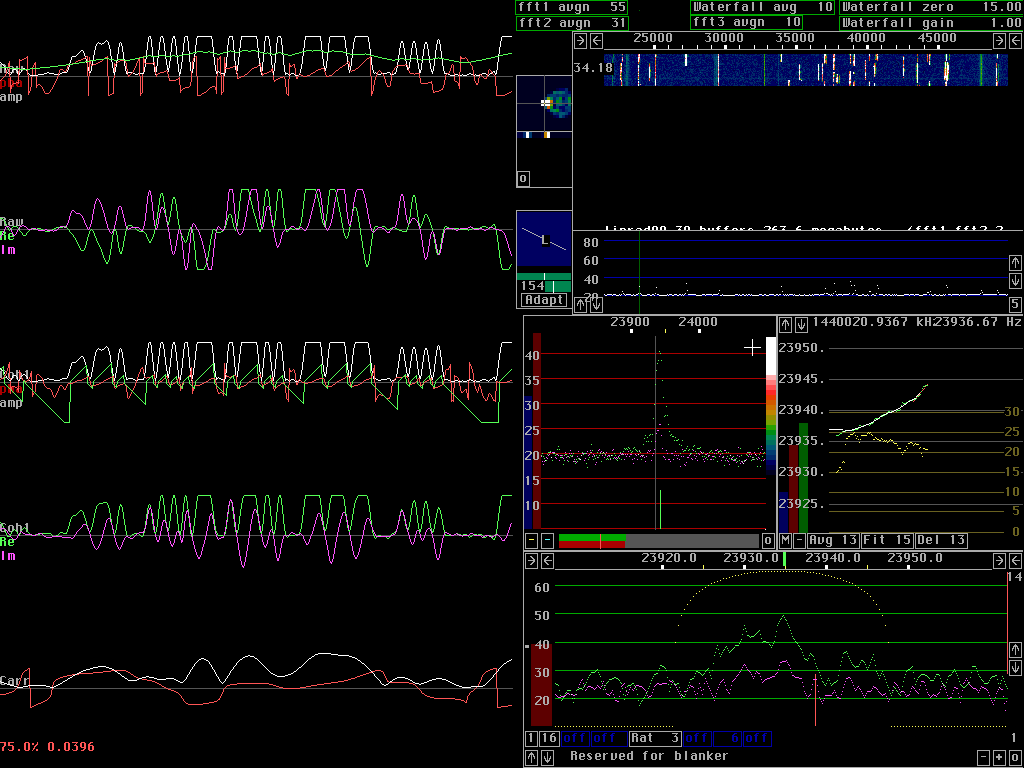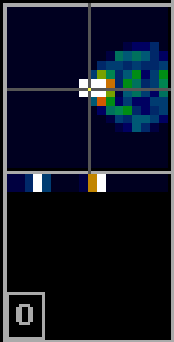Wideband EME recordingsDuring the ARRL EME contest 2001 several hours of EME signals was recorded using the large X-yagi array of SM5FRH. The recorded bandwidth is about 90kHz and a very large number of stations can be monitored for a long time in these recordings to evaluate signal levels, Faraday rotation and qsb characteristics.The data may be interesting for many reasons in the future and to store it safely and to also make it available to anyone interested all the data is placed on an Internet server. When unpacked, these data files can be played directly by Linrad as if they were coming fron the antenna at SM5FRH's EME station.
frh1135.bz2 213032622 bytes from sm5bsz.com. Oscilloscope tracksThe signals are from the beginning of the first file that starts at 11.35 UTC, Oct 14th 2001All screen dumps show signal vs time on the left side of the screen. Like other "oscilloscope functions" in Linrad it these tracks are enabled by clicking in the corresponding box with an "o" in it. In this case in the coherent/decode graph, the double window above the polarisation graph. In Linrad00-38, the oscilloscope tracks are as follows from top to bottom: Level 1: Raw data. The complex baseband signal as it looks when it comes out from the filter. This is the signal routed to the loudspeaker in normal receive mode (after a frequency shift specified by the BFO frequency). The white track is the amplitude. The red track is the phase angle. The abrupt phase changes are not real, -PI and +PI radians is the same phase! The green track is a detect threshold for the first step of decoding the morse code. Level 2: Raw data. The same data as level 1. The green track is I and the magenta track is Q. Level 3: Signal after the phase is twisted by the carrier phase (coherent processing). The white track is the amplitude (identical to the amplitude in level 1). The red track is the phase. The green track is ramps that decode key up or key down using the threshold of level 1. Level 4: Sams signal as in level 3. This time shown as the complex amplitude I and Q in the same way as in level 2. Level 5: Carrier. White is amplitude and red is phase. Phase characteristics of EME signalsFig. 1. shows F3VS during a normal qsb peak. The signal peak level is about 40 dB above the noise floor. With the selected filter, the softest available in linrad, a morse code bit has a weak tail that extends long enough before and after each key down to prevent the random phase of the noise 40dB lower to become visible.The carrier is extracted from a filter with 10 times narrower bandwidth than the signal. It is quite clear from the level 4 tracks that using I for both ears while throwing away Q will not cause any noticeable loss of signal. Due to the 10 times narrower bandwidth, S/N for the carrier is 7dB above S/N in the main channel. (assuming 50% of the power in the carrier) The noise passing through the carrier filter will not cause any problem. |

|
The EME path varies with time. The moon can be seen as
several reflectors moving at slightly different speeds.
Sometimes the signals add, sometimes the signal cancel
each other. We may call it multipath fading.
|

|
During QSB peaks, the main reflections are in phase - that is why the signal is above average. We can understand minima as if the two dominating signals are of about the same amplitude and of opposite phase. Fig. 2 shows the signal of F3VS a few seconds later compared to fig. 1. In fig.2 the signal goes through zero and the phase makes an abrupt twist by 180 degrees. We can understand is as if the two signals that nearly cancel each other change slowly in relative amplitude. Note that the phase of the carrier makes a very fast 180 degree twist. When the carrier has a more or less constant amplitude, the phase can not change rapidly because of the narrow bandwidth, but if the carrier goes through zero the phase can reverse in no time. This way the phase of the carrier fits the phase of the signal all the time as can be seen in the level 3 and level 4 traces. Chirpy and unstable signalsNot all signals are phase stable like those of F3VS shown in figures 1 and 2. Fig. 3 shows the signal from G4LOH which has a severe chirp from a coherent processing point of wiev. When listening to the signal by ear, this chirp is not audible.The baseband spectrum does not show a carrier with symmetric sidebands around it. To allow the carrier through the carrier filter all of the time it is necessary to select the widest possible bandwidth, only 3 times narrower than the main filter. |

|
As can be seen in figure 3, the average phase is made zero by the coherent processing. Checking both I and Q over a time that is 3 times longer than the characteristic time of the main filter will add some information that makes decoding cw better even though receiving I only by ear will not be a good idea for the G4LOH signal. The average phase is zero, but the instantaneous phase may be 45 degrees so throwing away Q would cause a serious loss of information. |

|
When using the minimum coherence factor 3, the bandwidth of the carrier if forced to be 3 times narrower than the bandwidth of the main filter. If the main filter is correctly selected, the characteristic time will fit the length of a morse code dot. This means that the minimum characteristic time of the carrier will fit a dash. When using the minimum coherence ratio, most of the signals on 144MHz are stable enough to allow some enhancement over normal filtering by use of coherent mode 2. This is illustrated in fig.4. In the recordings made 2001, approximately 50% of the stations have sufficient stability to allow use of coherent mode 3 with coherence factors above 3. The coherent graphFig 5 and fig. 6 are magnifications of the coherent graphs from F3VS and G4LOH respectively.The upper half shows statistics of I and Q amplitudes. For F3VS all points are very near to 0 degrees, they fall on a straight line from the origin to the left. For G4LOH, the points scatter over an area corresponding to +/- 45 degrees. The phase statistics is an indicator that shows if the coherence factor is set too high for the currently processed signal. The coloured areas below the center show statistics of the decoded signal, the length of the positive ramps of the level 3 oscilloscope traces. The midpoint is 3 times the caracteristic time of the selected filter. When the bandwidth is correctly set, one bright region should be near the center of the graph for morse code dashes. There should also be a bright region corresponding to the dots at 1/6 of the graph width. |

|
|
